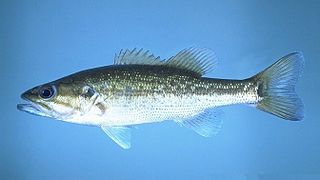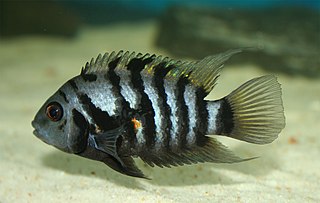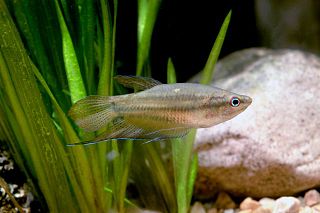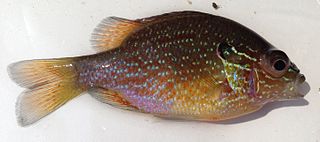
The spotted bass, also called spotty, or spots in various fishing communities, is a species of North American freshwater fish belonging to the sunfish family (Centrarchidae) of the order Perciformes. It is noted for the rows of dark spots below the lateral line, which give it its common name. One of the black basses, it is native to the Mississippi River basin and across the Gulf states, from central Texas through the Florida panhandle. Its native range extends into the western Mid-Atlantic states and it has been introduced into western North Carolina and Virginia. It has also been introduced to southern Africa, where it has become established in some isolated waters as an invasive species.

The largemouth bass is a carnivorous freshwater ray-finned fish in the Centrarchidae (sunfish) family, native to the eastern and central United States, southeastern Canada and northern Mexico. It is known by a variety of regional names, such as the widemouth bass, bigmouth bass, black bass, bucketmouth, largie, Potter's fish, Florida bass, Florida largemouth, green bass, bucketmouth bass, green trout, Gilsdorf bass, Oswego bass, LMB, and southern largemouth and northern largemouth.

The Jack Dempsey is a species of cichlid fish that is native to freshwater habitats from southern Mexico to Honduras, but also introduced elsewhere. Its common name refers to its aggressive nature and strong facial features, likened to that of the famous 1920s boxer Jack Dempsey.

The pumpkinseed, also referred to as pond perch, common sunfish, punkie, sunfish, sunny, and kivver, is a small/medium-sized North American freshwater fish of the genus Lepomis, from family Centrarchidae in the order Perciformes.

The warmouth is a freshwater fish of the sunfish family (Centrarchidae) that is found throughout the eastern United States. Other local names include molly, redeye, goggle-eye, red-eyed bream, and strawberry perch.

The redbreast sunfish is a species of freshwater fish in the sunfish family of the order Perciformes. The type species of its genus, it is native to the river systems of eastern Canada and the United States. The redbreast sunfish reaches a maximum recorded length of about 30 centimetres (12 in).

The green sunfish is a species of aggressive freshwater fish in the sunfish family (Centrarchidae) of order Perciformes. A panfish popular with anglers, the green sunfish is also kept as an aquarium fish by hobbyists, they need a 55-75 gallon tank and can be fed minnows, mealworms, or nightcrawlers. They are usually caught by accident, while fishing for other game fish. Green sunfish can be caught with live bait, such as nightcrawlers, waxworms, mealworms, and blood worms. Grocery store baits, such as pieces of hot dog or corn kernels, can even catch fish. Green sunfish are aggressive and will hit small lures. They can be caught with fly fishing tackle. They are extremely aggressive and will attack swimmers. They usually get 10 inches long, but in some cases they can get 12 inches long.

The longear sunfish is a freshwater fish in the sunfish family, Centrarchidae, of order Perciformes. It is native to the area of eastern North America stretching from the Great Lakes down to northeastern Mexico. The longear sunfish reaches a maximum recorded length of about 24 cm (9.4 in), with a maximum recorded weight of 790 g (1.74 lb). Most do not live beyond six years. The longear sunfish is quite colorful, with an olive to rusty-brown back, bright orange belly and blue-green bars on the sides of its head. A unique characteristic is their elongated operculum flap, giving an appearance of a "long ear".

The convict cichlid is a fish species from the family Cichlidae, native to Central America, also known as the zebra cichlid. Convict cichlids are popular aquarium fish and have also been the subject of numerous studies on fish behaviour.

Mayaheros urophthalmus, also known as the Mayan cichlid or Mexican mojarra is a species of cichlid.

The croaking gourami is a species of small freshwater labyrinth fish of the gourami family. They are native to still waters in Southeast Asia and are distributed worldwide via the aquarium trade. Croaking gouramis are capable of producing a "croaking" noise using their pectoral fins.

The Texas cichlid, also known as the Rio Grande cichlid, is a freshwater fish of the cichlid family, and the only cichlid species that is native to the United States. It is found in the lower Rio Grande drainage in Texas near Brownsville and northeastern Mexico.

The three spot cichlid, also known as the trimac or red-eyed cichlid, is a species of cichlid from Mexico and Central America, from the subfamily Cichlasomatinae. It is rarely found as an aquarium fish. Although still included as a highly aberrant member of Cichlasoma by FishBase, other authorities such as Catalog of Fishes have moved it to the genus Amphilophus.

Palaemon paludosus, commonly known as ghost shrimp, glass shrimp, and eastern grass shrimp, is a species of freshwater shrimp from the southeastern United States. They can be considered a keystone species based on the services they provide to their habitat. They are also popular in the domestic aquarium business.

The banded pygmy sunfish, Elassoma zonatum, is a species of pygmy sunfish endemic to the United States, where it is found from Indiana and Illinois to Texas to the Atlantic coast. It prefers densely vegetated bodies of slow-moving water. This species can reach 4.7 cm (1.9 in) in total length, though most do not exceed 3.5 cm (1.4 in).

The spotted sunfish, also known as a stumpknocker, is a member of the freshwater sunfish family Centrarchidae and order perciformes. The redspotted sunfish, redear sunfish and pumpkinseed sunfish are its closest relatives. Lepomis punctatus is olive-green to brown in color with black to reddish spots at the base of each scale that form rows of dots on the side. The scientific name punctatus refers to this spotted pattern. It was first described in 1831 by Valenciennes.

Mylopharadon conocephalus, known as the hardhead, is a freshwater ray-finned fish from the family Cyprinidae, the carps and minnows, which is endemic to California. It is the sole member of the monotypic genus Mylopharadon.

The dollar sunfish is a species of freshwater fish in the sunfish family of order Perciformes. It is categorized as a warm water pan-fish. Early settlers said that this species of sunfish resembled a European species they called bream. Historically it has been found along the Southern Atlantic coastal drainages from North Carolina to Florida, and west to Texas. Lepomis marginatus mainly feeds on detritus and filamentous algae as well as a few terrestrial insects. The juvenile and mature fish do not have many predators, but the eggs in the nest are in danger of predation from a few different species of fish.

The blackbanded sunfish is a freshwater fish species of the sunfish family (Centrarchidae). They are found in the United States ranging from New Jersey to central Florida.> The defining feature of this Black-banded sunfish is the black vertical strips that it has on both sides of its body. The term "Enneacanthus" comes from the Greek terms ennea, which means "nine times", and acanthi, which means "thorn". It is in a genus that consists of only three species along with the Banded Sunfish and the Bluespotted Sunfish. Collectively, they are commonly referred to as the "Banded Sunfish" or "Little Sunfish".

Hemichromis letourneuxi is a species of cichlid which is native to West Africa and is popular in the aquarium hobby and it has been introduced to the Caribbean and the south-east United States where it is invasive.




















